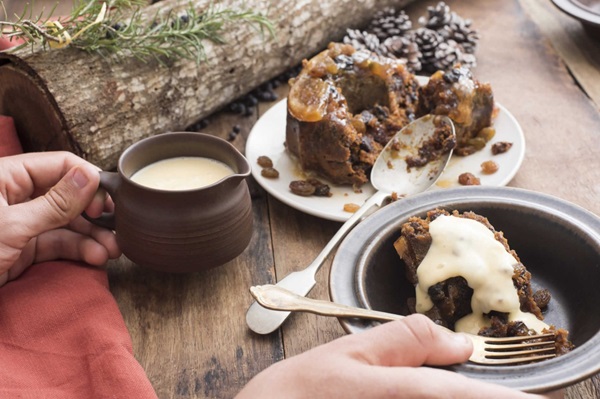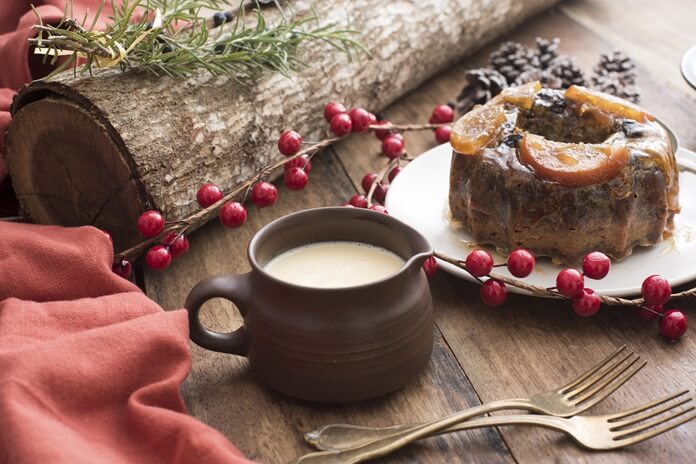Today, we celebrate Stir-Up Sunday, which falls on the last Sunday before Advent Sunday (November 24 this year). This day is known for making Christmas puddings with family. Originally, it was a religious day for Christians with special Bible readings. Since the Victorian era, it has become a day for family gatherings and cooking. Traditionally, families stir the pudding and make wishes for the new year. Besides enjoying time together, it’s also a good opportunity to start checking off items on your Christmas to-do list, like making pudding!
History of Stir-Up Sunday
Anyone from Britain can tell you how wonderful a Christmas pudding is at the end of Advent! But this traditional dish has changed a lot over the years. With different ingredients and traditions, Christmas pudding is a big part of Stir-Up Sunday and has a fascinating history.
In the 1300s, the earliest versions of Christmas pudding were made. They were a type of porridge called ‘frumenty,’ made from beef, mutton, spices, wine, and dried fruits like prunes. Before Advent, many people would fast, and frumenty would be their final meal to prepare for the season.
Over the next two hundred years, frumenty evolved into what we now call plum pudding. People started adding breadcrumbs, eggs, dried fruit, and alcohol, which improved its flavour and texture.
Moreover, by around 1650, it became a popular Christmas dinner dish, but this didn’t last long. In 1664, strict Puritans banned it, calling it an evil meal.

The story changed in 1714 when George I of Germany brought it back because he loved plum pudding. Since then, Christmas pudding has become a key part of Victorian Christmas.
The exact origins of Stir-Up Sunday are unclear, but the tradition dates back to Victorian times. Families would stir the pudding together a few weeks before Christmas, making a wish with each stir. The holiday’s name goes back even further, to 1549, from the Book of Common Prayer, which begins with “Stir-up, we beseech thee, O Lord.”
Nowadays, we enjoy Christmas pudding which is most similar to plum pudding. Although Stir-Up Sunday has religious origins, it’s often just a fun holiday for families to come together and bake their Christmas pudding!
Timeline of Stir-Up Sunday
| 1300s (Early Christmas Pudding) | The Christmas porridge that emerged in the 1300s bears little resemblance to today’s Christmas pudding — it is made with beef, mutton, prunes, raisins, currants, wine, and spices. |
| 1549 (Book of Common Prayer) | The opening words of the collect in the Book of Common Prayer of 1549 are “Stir-up, we beseech thee, O Lord…” — which is where the holiday gets its name. |
| 1595 (Pudding Evolves) | From its 14th-century roots, Christmas plum pudding takes on a new form with the addition of eggs, breadcrumbs, dried fruit, and spirits. |
| 1650–1664 (A Christmas Classic) | In 1650, the classic pudding recipe became a staple around the holidays, but it was short-lived — it was banned by Puritans in 1664 as an evil custom. |
| 1714 (Pudding Reinstated) | Though many say that Christmas pudding was introduced by Prince Albert, Queen Victoria’s consort, others speculate that it was George I of Germany who brought it back in 1714. |
5 Interesting Facts About Stir-Up Sunday
- The Lucky Stir Has a Prescribed Direction: Families traditionally stir the pudding from east to west, honouring the wise men who travelled in that direction to see baby Jesus.
- It’s Not Called ‘Stir-Up’ Because of Cooking: The name ‘Stir-Up Sunday’ comes from the opening lines of the collect in the Book of Common Prayer (1549): “Stir-up, we beseech thee, O Lord…”
- Puddings Traditionally Include 13 Ingredients: A traditional Christmas pudding includes 13 ingredients to represent Christ and his 12 disciples.
- Every Family Member Gets a Wish: When making the pudding, each family member makes a wish while stirring.
- Puddings Once Included Symbols for Good Luck: Old-fashioned Christmas puddings sometimes had symbols like a thimble for a lucky life or a ring for good fortune in marriage.
Conclusion
Stir-Up Sunday blends rich tradition and festive joy. Celebrated on the last Sunday before Advent, it is a cherished occasion for families to come together and make Christmas pudding. This day connects us with history, from its 14th-century origins to Victorian traditions. It’s not just about pudding; it’s a moment for family bonding and wish-making. As we stir the pudding and make our wishes, we honor a tradition that has evolved and endured through the centuries.
Frequently Ask Question
When is Stir-Up Sunday celebrated?
Stir-Up Sunday falls on the last Sunday before Advent Sunday, which is November 24 this year.
What is the history behind Stir-Up Sunday?
Stir-Up Sunday has roots in the 1300s with early versions of Christmas pudding. The tradition gained prominence during the Victorian era, when families began stirring pudding together and making wishes.
Why is it called Stir-Up Sunday?
The name “Stir-Up Sunday” originates from the opening lines of the 1549 Book of Common Prayer: “Stir-up, we beseech thee, O Lord…”
What are the traditional practices associated with Stir-Up Sunday?
Families traditionally stir the Christmas pudding together and make a wish with each stir. The pudding often contains 13 ingredients to represent Christ and his 12 disciples.
What is the origin of Christmas pudding?
Christmas pudding evolved from a 14th-century porridge called frumenty, which was made with beef, mutton, and dried fruits. It later transformed into plum pudding and eventually, the Christmas pudding we know today.
You may also like to read, National Eggnog Day – December 24, 2024
